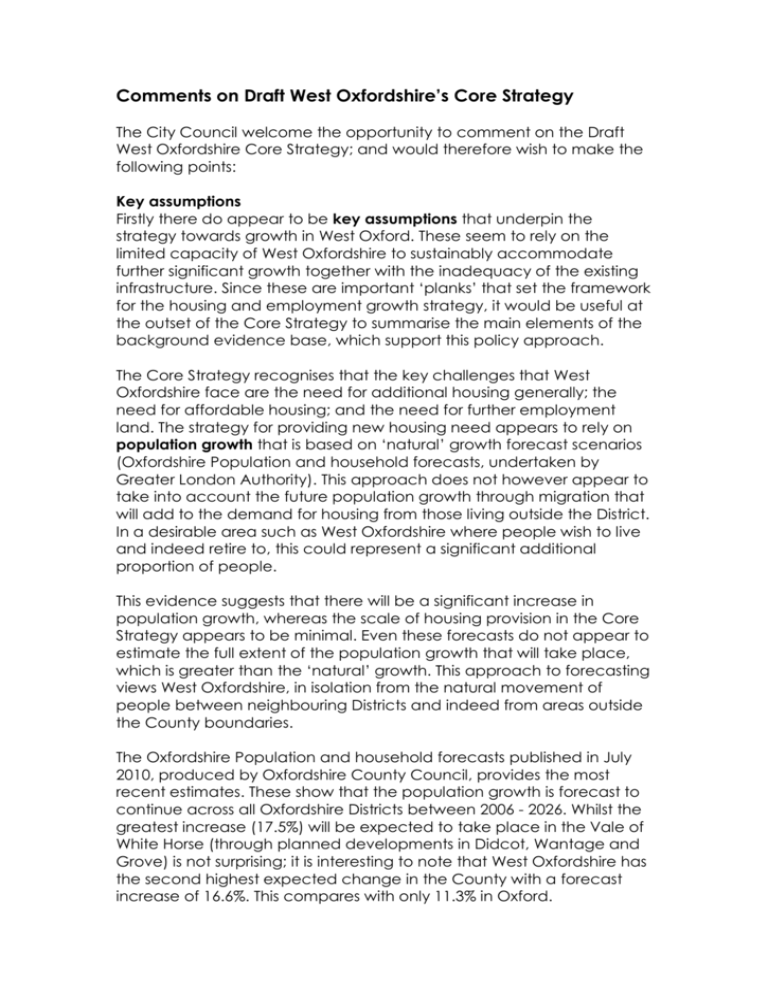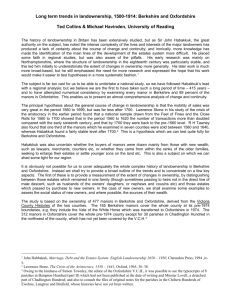Oxford City Council - Planning Policy Consultations
advertisement

Comments on Draft West Oxfordshire’s Core Strategy The City Council welcome the opportunity to comment on the Draft West Oxfordshire Core Strategy; and would therefore wish to make the following points: Key assumptions Firstly there do appear to be key assumptions that underpin the strategy towards growth in West Oxford. These seem to rely on the limited capacity of West Oxfordshire to sustainably accommodate further significant growth together with the inadequacy of the existing infrastructure. Since these are important ‘planks’ that set the framework for the housing and employment growth strategy, it would be useful at the outset of the Core Strategy to summarise the main elements of the background evidence base, which support this policy approach. The Core Strategy recognises that the key challenges that West Oxfordshire face are the need for additional housing generally; the need for affordable housing; and the need for further employment land. The strategy for providing new housing need appears to rely on population growth that is based on ‘natural’ growth forecast scenarios (Oxfordshire Population and household forecasts, undertaken by Greater London Authority). This approach does not however appear to take into account the future population growth through migration that will add to the demand for housing from those living outside the District. In a desirable area such as West Oxfordshire where people wish to live and indeed retire to, this could represent a significant additional proportion of people. This evidence suggests that there will be a significant increase in population growth, whereas the scale of housing provision in the Core Strategy appears to be minimal. Even these forecasts do not appear to estimate the full extent of the population growth that will take place, which is greater than the ‘natural’ growth. This approach to forecasting views West Oxfordshire, in isolation from the natural movement of people between neighbouring Districts and indeed from areas outside the County boundaries. The Oxfordshire Population and household forecasts published in July 2010, produced by Oxfordshire County Council, provides the most recent estimates. These show that the population growth is forecast to continue across all Oxfordshire Districts between 2006 - 2026. Whilst the greatest increase (17.5%) will be expected to take place in the Vale of White Horse (through planned developments in Didcot, Wantage and Grove) is not surprising; it is interesting to note that West Oxfordshire has the second highest expected change in the County with a forecast increase of 16.6%. This compares with only 11.3% in Oxford. Housing strategy The policy approach on new residential development does seem to rely on meeting a ‘local’ housing need that does not fully reflect the sub-regional context. Indeed the need for housing generally within the sub-regional area is significant and is only likely to be met in the future with a co-ordinated approach among Districts with each meeting a proportion of the growth. In the absence of the Regional Spatial Strategies (RSS’s) soon to be formally abolished, the only framework for considering the implications of meeting forecast housing demand at the wider sub-regional level will be through the newly formed Oxfordshire City Region LEP. Whilst this organisation is at the early stages planning and housing growth are intended to be key strategic issues, which will be discussed between the County, District representatives and the business community. It would therefore be helpful if the Core Strategy made reference to this wider spatial setting, which will be of greater significance in the future, particularly given the longer time period for this plan. The Core Strategy sub-divides West Oxfordshire into five areas, which serves to illustrate how over time each area will change. But the overall amount and distribution of housing shows that with a forecast requirement of 4,300 homes and 1,200 already committed there is only a modest requirement of 3,100 new homes planned to 2027. This is significantly less than the South East Plan target of 7,300 homes, and therefore potentially places added pressure on neighbouring district authorities to meet future housing need. West Oxfordshire is characterised by high house prices; few social rented properties; and a significant projected increase in older people. These represent some of the key challenges for the Core Strategy to address. It is not however clear from the spatial strategy whether the policies that are proposed will be able to fully address the scale and nature of the increase in population, including migration, that will need further housing which is affordable and able to meet this demand. In this context it is therefore surprising that the policy on the retention of existing housing is not stricter. The loss of the existing housing stock would probably benefit from being strictly safeguarded and only accepted in exceptional circumstances. Employment strategy The employment strategy is based on an Employment Land Review, which considers a range of scenarios. The Preferred approach suggested by the consultants is Scenario 1: Steady Growth (Business as Usual). The strategy now being proposed appears to be more akin to Scenario 3: Indigenous growth (constrained growth), which allocates little additional land but relies to a large extent on the existing land supply. This policy approach with few new sites coming forward does not promote sustainable economic prosperity for West Oxfordshire and is therefore unlikely to meet one of its key objectives to promote a greater level of self-containment for its local economy. It could potentially have two particular impacts which would be significant for neighbouring authorities. Firstly it would potentially increase the need for further employment land to be provided in other Districts, such as Oxford. Secondly there is a considerable amount of in-commuting from the rural areas, such as West Oxfordshire to the main centres of employment, such as Oxford. By limiting employment opportunities the Core Strategy will not make a significant contribution to reducing incommuting.










